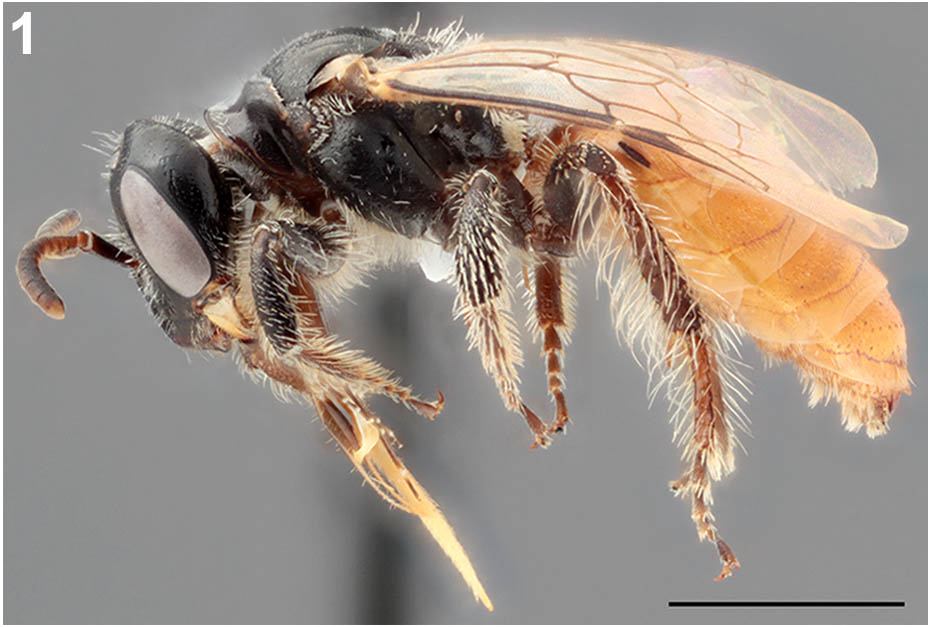First records, phenology, habitat, and host-plant associations of Macrotera opuntiae (Cockerell) (Hymenoptera: Andrenidae) in Montana
DOI:
https://doi.org/10.17161/jom.i102.13700Abstract
Abstract. Macrotera (Cockerellula) opuntiae (Cockerell) is a minute bee oligolectic on cacti and one of the few stone-nesting bee species. We document the first records of M. opuntiae in Montana, USA, a considerable range expansion from where this species was previously known in Colorado. We briefly describe the habitat and host-plant (cacti) associations, and the activity period of M. opuntiae adults in Montana. A new state record for Nebraska and new records for western Colorado are also reported.
References
Bennett, B., & M.D. Breed. 1985. The nesting biology, mating behavior, and foraging ecology of Perdita opuntiae (Hymenoptera: Andrenidae). Journal of the Kansas Entomological Society 58(2): 185–194.
Blanchette, G.E. 2019. Native pollinators: The effects of livestock grazing on Montana rangelands. Master’s thesis, Montana State University; Bozeman, MT; 114 pp.
Cockerell, T.D.A. 1922. Two new subgenera of North American bees. American Museum Novitates 47: 1–5.
Consortium of Pacific Northwest Herbaria. 2020. [http://www.pnwherbaria.org; last accessed 7 March 2020].
Custer, C.P. 1928. The bee that works in stone; Perdita opuntiae Cockerell. Psyche 35(2): 67–84.
Custer, C.P. 1929. Notes on cocoons and parasites of Melissodes obliqua and nests of Perdita opuntiae (Hymenoptera-Apoidea). Psyche 36(4): 293–295.
Danforth, B.N. 1996. Phylogenetic analysis and taxonomic revision of the Perdita subgenera Macrotera, Macroteropsis, Macroterella and Cockerellula (Hymenoptera: Andrenidae). University of Kansas Science Bulletin 55(16): 635–692.
Danforth, B.N., R.L. Minckley, & J.L. Neff. 2019. The Solitary Bees: Biology, Evolution, Conservation. Princeton University Press; Princeton, NJ; xi+472 pp.
Delphia, C.M. 2019. First records of Xylocopa virginica (Linnaeus) (Hymenoptera: Apidae) in Montana and Idaho. Journal of the Kansas Entomological Society 92(4): 655–659.
Delphia, C., T. Griswold, E. Reese, K. O'Neill, & L. Burkle. 2019. Checklist of bees (Hymenoptera: Apoidea) from small diversified vegetable farms in south-western Montana. Biodiversity Data Journal 7: e30062.
DeVelice, R.L., & P. Lesica. 1993. Plant community classification for vegetation on BLM lands, Pryor Mountains, Carbon County, Montana. Montana Natural Heritage Program; Helena, MT; 78 pp.
Dolan, A.C., C.M. Delphia, K.M. O’Neill, & M.A. Ivie. 2017. Bumble bees (Hymenoptera: Apidae) of Montana. Annals of the Entomological Society of America 110(2): 129–144.
Greenleaf, S.S., N.M. Williams, R. Winfree, & C. Kremen. 2007. Bee foraging ranges and their relationship to body size. Oecologia 153(3): 589–596.
Hunter, J.P., J.H. Hartman, & D.W. Krause. 1997. Mammals and mollusks across the Cretaceous-Tertiary boundary from Makoshika State Park and vicinity (Williston Basin), Montana. Rocky Mountain Geology 32(1): 61–114.
Intermountain Region Herbarium Network. 2020. [http://intermountainbiota.org; last accessed 7 March 2020].
Kuhlman, M. & S. Burrows. 2017. Checklist of bees (Apoidea) from a private conservation
property in west-central Montana. Biodiversity Data Journal 5: e11506.
Lavigne, R.J., & V.J. Tepedino. 1976. Checklist of the insects of Wyoming. I. Hymenoptera. Wyoming Agricultural Experiment Station Research Journal 106: 1–61.
Lesica, P. 2012. Manual of Montana Vascular Plants. BRIT Press; Fort Worth, TX; vii+771 pp.
Lyman, J., K. Flathers, & S. Durney. 2015. A Botanical Guide to Special Places in the Pryor Mountains. [http://www.pryormountains.org/natural-history/botany/botanical-guide/; last accessed 20 February 2020].
Michener, C.D. 2007. The Bees of the World [2nd Edition]. John Hopkins University Press; Baltimore, MD; xvi+[i]+953 pp., +20pls.
Montana Fish, Wildlife, and Parks. 2005. Makoshika State Park Management Plan. [http://fwp.mt.gov/; last accessed 8 March 2020].
Montana Native Plant Society. 2020. Important Plant Areas. [https://www.mtnativeplants.org/important-plant-areas/; last accessed 3 April 2020].
Pryors Coalition. 2020. The Pryor Mountains. [http://www.pryormountains.org; last accessed 6 March 2020].
Reese, E., L. Burkle, C. Delphia, & T. Griswold. 2018. A list of bees from three locations in
the Northern Rockies Ecoregion (NRE) of western Montana. Biodiversity Data Journal 6: e27161.
Timberlake, P.H. 1954. A revisional study of the bees of the genus Perdita F. Smith, with special reference to the fauna of the Pacific coast (Hymenoptera, Apoidea) Part I. University of California Publications in Entomology 9(6): 345–432.
Timberlake, P.H. 1960. A revisional study of the bees of the genus Perdita F. Smith, with special reference to the fauna of the Pacific coast (Hymenoptera, Apoidea) Part IV. University of California Publications in Entomology 17(1): 1–156.
Wheeler, R. 1995. Ecological phenomena and their effect on the flora of Makoshika State Park. Honors thesis, Carroll College; Helena, MT; 34 pp.
Downloads
Published
Issue
Section
License
Copyright (c) 2021 Casey Delphia, Terry Griswold

This work is licensed under a Creative Commons Attribution-NonCommercial-NoDerivatives 4.0 International License.
Copyright for articles published in Journal of Melittology is retained by the authors, with first publication rights granted to the journal. By virtue of their appearance in this open access journal, articles are free to use, with proper attribution and permission of the authors, in educational and other non-commercial settings.





